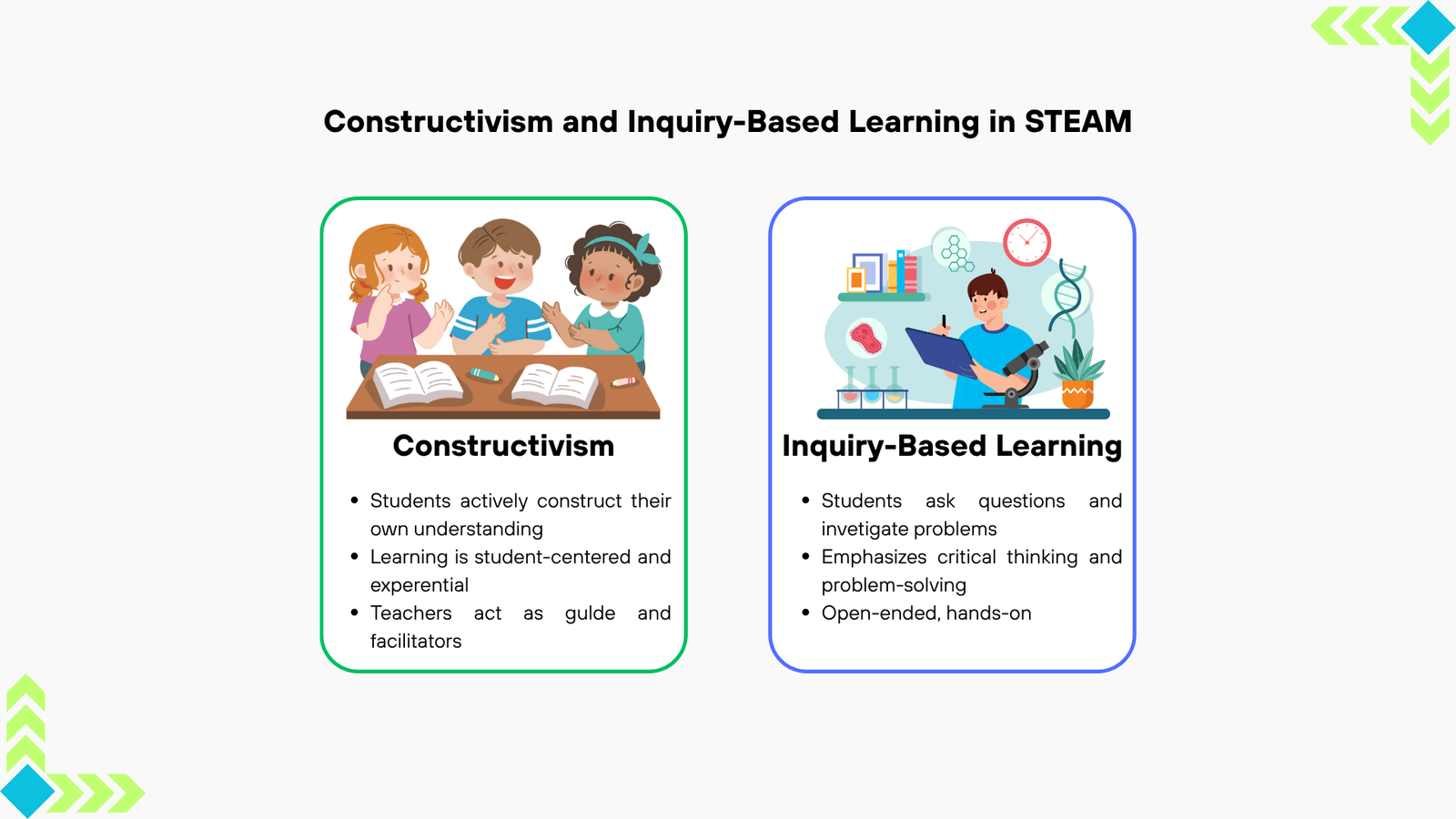Lesson 2.2: Constructivism and Inquiry-Based Learning in STEAM

Constructivist learning is transforming how educators approach teaching in the 21st century. In an era that demands innovation, collaboration, and adaptability, traditional teaching methods that emphasize rote memorization no longer suffice. Instead, students must be active participants in their learning—exploring, questioning, and constructing meaning through direct experience.
When combined with STEAM education which integrates Science, Technology, Engineering, Arts, and Mathematics constructivism provides a dynamic, student-centered approach that encourages critical thinking, creativity, and real-world problem-solving. This article explores the principles of constructivist learning, its integration within STEAM and makerspace environments, and the competencies teachers need to facilitate this model effectively.
What Is Constructivist Learning?
Constructivist learning is an educational philosophy that emphasizes how learners actively build knowledge rather than simply receiving it from a teacher. Students are not empty vessels to be filled with facts, but thinkers who interpret new information through the lens of their existing knowledge and experiences.
Core Principles of Constructivism
According to Suparlan (2019), several key principles define constructivist learning:
-
Knowledge Is Constructed, Not Transmitted
Learners actively build their understanding through exploration and reflection. Teachers provide guidance, but knowledge itself cannot simply be transferred. -
Learning Requires Active Engagement
Passive listening is not enough. Students must participate in discussions, solve problems, and engage in hands-on activities to internalize concepts. -
Learning Is Personal and Social
While individual exploration is essential, social interaction enhances learning. Group discussions, peer collaboration, and feedback help students refine their thinking. -
Teachers Are Facilitators, Not Lecturers
The role of the teacher shifts from “knowledge dispenser” to “learning coach.” Teachers create an environment where students feel empowered to ask questions and make discoveries.
By focusing on these principles, educators foster a deeper, more meaningful learning experience—one that encourages students to become independent thinkers and lifelong learners
The Role of Teachers in Constructivist and STEAM Classrooms
In a constructivist STEAM classroom, teachers become mentors who design learning experiences that allow students to explore interdisciplinary topics in creative and inquiry-driven ways.
Shifting Roles: From Authority to Guide
In this model, the teacher’s responsibilities include:
-
Designing open-ended activities that require analysis, evaluation, and synthesis.
-
Creating safe learning environments where students feel comfortable taking intellectual risks.
-
Asking guiding questions that lead students to deeper insights, rather than giving direct answers.
-
Encouraging self-assessment and reflection so students understand their learning processes.
Constructivist teaching aligns closely with inquiry-based learning (IBL), problem-based learning (PBL), and project-based learning, all of which promote higher-order thinking and real-world application.
Why STEAM and Constructivism Work So Well Together
STEAM education emphasizes integration across disciplines and encourages students to think critically, solve complex problems, and create innovative solutions. The constructivist approach complements STEAM in several key ways:
1. Student-Led Exploration
In both STEAM and constructivism, students lead their learning journey by posing questions, testing hypotheses, and constructing new knowledge.
2. Emphasis on Process Over Product
Instead of simply aiming for a “correct” answer or final product, the focus is on learning how to learn—analyzing failures, iterating on ideas, and developing perseverance.
3. Creativity and Innovation Through Arts Integration
The “A” in STEAM brings in the Arts, allowing for creative expression and divergent thinking, both essential to the constructivist mindset.
4. Authentic Context and Real-World Relevance
STEAM projects often mirror real-world challenges, enabling students to apply their learning in meaningful contexts, enhancing motivation and long-term retention.
Makerspaces: A Constructivist Playground
Makerspaces—creative, tech-rich environments where students design, build, and experiment—are perfect settings for applying constructivist learning within a STEAM framework.
Why Makerspaces Support Constructivist Learning
-
Hands-On Learning: Students use tools, materials, and digital technologies to bring abstract concepts to life.
-
Peer Collaboration: Shared space fosters teamwork and communication.
-
Reflection and Iteration: Students continually test, fail, redesign, and improve their creations.
Makerspaces also align with constructionism, a branch of constructivism developed by Seymour Papert, which emphasizes building physical or digital artifacts as a means of learning.
The Power of Inquiry-Based Learning in STEAM
Inquiry-Based Learning (IBL) complements constructivism by encouraging students to drive the learning process through questioning and investigation. In STEAM education, IBL:
-
Encourages cross-disciplinary thinking.
-
Develops metacognition and higher-order thinking skills.
-
Moves along a continuum from structured inquiry (teacher-guided) to open inquiry (student-led).
In open inquiry, learners define their own problems, conduct research, analyze findings, and present innovative solutions. This not only nurtures academic growth but also prepares students for complex, real-life challenges.
Teacher Competencies for Constructivist and STEAM Learning
To implement this approach effectively, teachers need specific competencies:
-
Subject Mastery
A deep understanding of the content across STEAM disciplines, including how they interconnect. -
Instructional Design
Skills to design interdisciplinary, inquiry-based activities that engage students and foster deep learning. -
Technological Proficiency
Ability to integrate ICT tools, including virtual labs, design software, and remote learning platforms. -
Psychological and Pedagogical Insight
Strategies to support diverse learners, foster motivation, and scaffold learning experiences appropriately. -
Hands-On and Lab Skills
Comfort with experimentation and guiding students through technical processes in labs or makerspaces.
These competencies are typically developed through targeted professional development, certification courses, and hands-on experience.
Conclusion: Preparing Students for the Future Through Constructivism and STEAM
Constructivist learning, when combined with STEAM principles, creates a transformative educational experience. Students are not only mastering academic content—they’re learning how to think critically, collaborate, and innovate.
In this model, learning is not about memorizing facts for a test. It’s about discovering how to solve problems, express ideas, and adapt in an ever-changing world.
As classrooms evolve with technology and new pedagogies, embracing constructivism is essential to making learning relevant, engaging, and future-ready.
